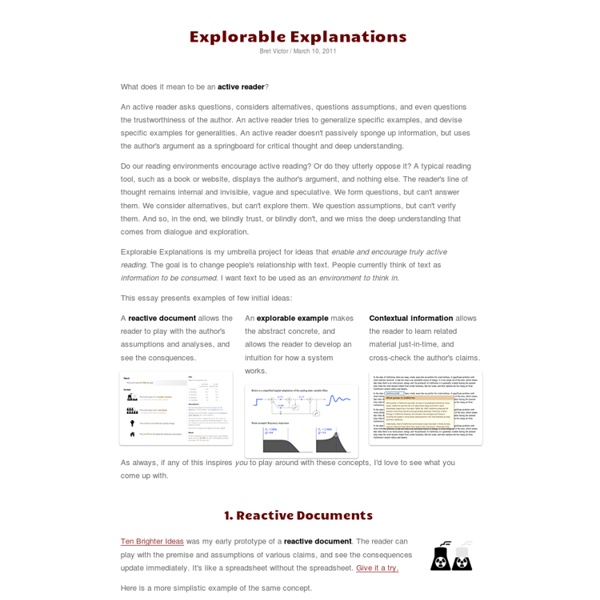The Sexperience 1000 - Sexperience
Welcome to The Sexperience 1000, an interactive journey through the sexual experiences and preferences of one thousand British individuals. What’s the favourite sexual position of iPhone users in the North? Do country music lovers over 55 prefer to do it in the dark? Explore the 20 questions of our survey and discover what the great British public get up to between the sheets… Filter Filter by region, age, etc. and compare to yourself. Track Track particular groups of respondents to see how they answered other questions. Follow Found someone fascinating?
EPUB Really IS a Container
"It's OK for libraries to put things in their EPUB books." That's what Bill Kasdorf, a member of the EPUB Working Group, told me last week at the IDPF Digital Book 2011 Meeting. He checked with EPUB Revision Co-Editor Markus Gylling to make sure. It may seem an odd question if you don't know a few things about EPUB. The EPUB specs define a lot more than just a file format. OCF uses the ubiquitous ZIP format to wrap up all a book's resource files into a neat, transportable package. There's even a reserved name for a file to contain book level metadata in OCF: META-INF/metadata.xml, as well as another file for rights information, META-INF/rights.xml. The new EPUB revision is coming fast. Although Amazon still uses the aging MOBI format on its kindle devices, it seems only a matter of time before the infrastructure accumulating behind EPUB pushes them into the embrace of the IDPF. EPUB 3 comes with lots of goodies. Libraries face a similar dilemma.
Up and Down the Ladder of Abstraction
In real life, you would never use a ladder that only let you go up. Likewise, when creating abstractions, stepping down is as important as stepping up. Here, we take the abstraction from the previous section, and overlay a concrete representation on top of it. That is, we draw the trajectory that represents all time, but we also draw the car at some particular time. How do we select which particular time to show? This is a general and powerful technique. Try cranking up the turning rate to 8° or so, and then inspecting the car's behavior as it makes its first two turns. In this case, it's fairly easy to look at the trajectory and imagine the car moving along.
An Overview of the Euro Crisis - Interactive Graphic
Arrows show imbalances of debt exposure between borrowers in one country and banks in another; arrows point from debtors to their bank creditors. Arrow widths are proportional to the balance of money owed. For example, French borrowers owe Italian banks $50.6 billion; Italian borrowers owe French banks $416.4 billion. The difference — their imbalance — shows France's banking system more exposed to Italian debtors by about $365.8 billion. The risk to countries’ debts and economies is indicated by color: More worrisome Greece amassed a huge debt that it has scant hope of repaying. If there is no firewall or if it is inadequate, it would be easy to imagine a run on banks. If no preventative measures are taken, a chain of events like this could unfold: In reaction to a Greek collapse, investors become worried about their exposure to other risks in the region. Italy may not be able to protect its banks if there is a loss of confidence.
How Online Education Is Changing the Way We Learn [INFOGRAPHIC]
Over the past decade or so, the Internet has become a huge source of information and education, especially for those who might be short on time, money or other resources. And it's not just crowdsourced data collections like Wikipedia or single-topic blogs that encourage individual learning; huge corporations and nonprofits are making online education and virtual classrooms a very formal affair these days. From the first online classes (which were conducted by the University of Phoenix in 1989) to the present day, when online education is a $34 billion industry, more and more students are finding new life and career education opportunities online. Check out this infographic from OnlineEducation.net about how the world of online learning has changed and grown over the years. Click image to see larger version. [source: Online Education] Top image based on a photograph from iStockphoto user flyingdouglas.
Magic Ink: Information Software and the Graphical Interface
This draft was released March 15, 2006. Please email comments to bret worrydream.com. You can also download the PDF. Information Software and the Graphical Interface by Bret Victor Abstract #The ubiquity of frustrating, unhelpful software interfaces has motivated decades of research into “Human-Computer Interaction.” #Information software design can be seen as the design of context-sensitive information graphics. #Although this paper presents a number of concrete design and engineering ideas, the larger intent is to introduce a “unified theory” of information software design, and provide inspiration and direction for progressive designers who suspect that the world of software isn’t as flat as they’ve been told. Scope and terminology #“Software,” as used here, refers to user-facing personal desktop software, whether on a native or web platform. Of software and sorcery #A computational process is indeed much like a sorcerer’s idea of a spirit. #This is a software crisis, and it isn’t news.
Neatline.org | plot your course in space & time
Open Content Licensing for Open Educational Resources



